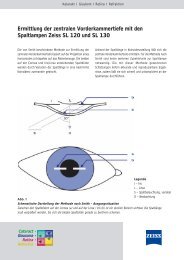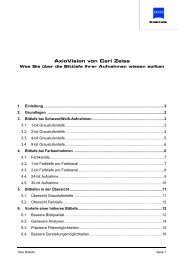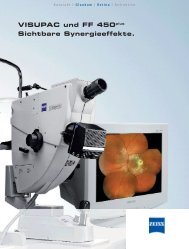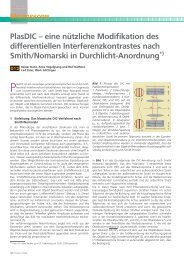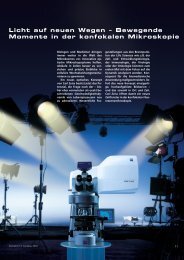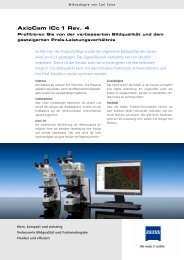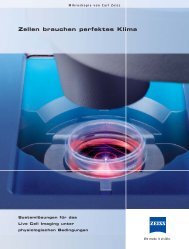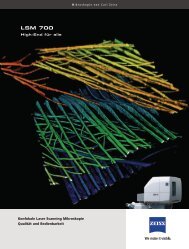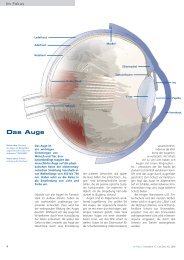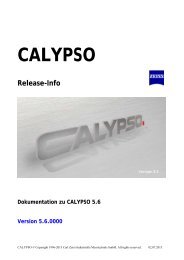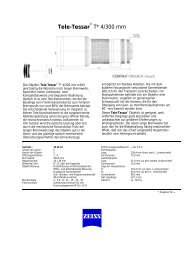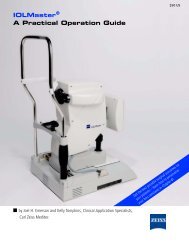Download - Carl Zeiss, Inc.
Download - Carl Zeiss, Inc.
Download - Carl Zeiss, Inc.
Create successful ePaper yourself
Turn your PDF publications into a flip-book with our unique Google optimized e-Paper software.
Imaging<br />
Figure 1: Advanced RPE Analysis of Case 1 – First<br />
Screen Analysis<br />
penetration of light is seen in the corresponding B-scan as well (see<br />
Figure 1, B-scan). The red line indicating the distance from the fovea<br />
to the closest area with sub-RPE illumination is very short and almost<br />
not visible in this analysis as GA has almost but not yet reached the<br />
fovea (see Figure 1, sub-RPE slab, left side).<br />
In the RPE elevation map, RPE elevations are seen, especially within<br />
the 5 mm circle. There are also elevations outside the measurement<br />
area, which is indicated by a warning message. The RPE elevations<br />
indicating drusen increase between the two visits (see Figure 1).<br />
Quantitative conclusions are presented in the calculation analysis in<br />
the second screen (see Figure 2).<br />
(1) Retinal pigment epithelium (RPE) elevation map overlaid on fundus image; (2) Circles on<br />
the RPE elevation map centred on the fovea location; (3) Sub-RPE slab with overlaid<br />
segmentation of sub-RPE illumination; (4) Horizontal tomogram showing RPE elevation<br />
segmentation line; (5) Fovea is marked as a red dot; line from fovea connecting closest sub-<br />
RPE illumination area. On the left side, data of prior visit are provided for direct comparison<br />
with data of the last visit (right side).<br />
Figure 2: Advanced RPE Analysis of Case 1 – Second<br />
Screen Analysis Exhibiting the RPE Profile, an Image<br />
that Combines the RPE Elevation Map and the Sub-RPE<br />
Illumination Segmentation<br />
Second screen analysis shows the ‘RPE profile’ which integrates RPE<br />
elevation map and sub-RPE illumination: the sub-RPE illumination is<br />
overlaid on the RPE elevation and shown as an outline. This slab shows<br />
the location of the fovea with a dot marking and a circle corresponding<br />
to 5 mm in diameter centred on the fovea. Furthermore, calculated<br />
values are presented in a table (see Figure 2). Calculated values show<br />
that from July 2011 until January 2012 the drusen area increased by<br />
0.4 mm (23.5 % change) within the 5 mm circle, whereas drusen<br />
volume increased from 0.06–0.07 mm 3 . In addition, the atrophic area<br />
changed from 0.6–0.7 mm 2 , which is within the test/retest variability<br />
for these measurements and thus could be regarded as measurement<br />
noise rather than real change (see Figure 2). These results correlate<br />
well with the authors’ clinical observation.<br />
Case 2<br />
Case 2 represents data of a 79-year-old female with confirmed dAMD<br />
with drusen and GA in both eyes. Both eyes had cataract surgery with<br />
implantation of a non-blue light filtering intraocular lens. There was no<br />
history of other eye operations apart from that. Best corrected visual<br />
acuity of the left eye was 0.25 and BCVA of the right eye was 0.16.<br />
SD-OCT data from left and right eye collected at first visit (October<br />
2011) are presented in a ‘Patient report’, which can be printed after<br />
Advanced RPE analysis and can be kept with the patient’s documents.<br />
The Patient report shows all relevant data including RPE elevation<br />
map (1), sub-RPE slab (2), RPE profile (3) and the calculation analysis<br />
(see Figure 3A and B).<br />
The sub-retinal pigment epithelium (RPE) illumination segmentation is overlaid on the RPE<br />
elevation map and shown with an outline. A table with calculated values of RPE elevation<br />
(area and volume) and atrophic area as well as a calculation of current minus prior and<br />
percentage change is also provided. For direct comparison, data of prior visit are provided<br />
on the left side, data of the last visit on the right side.<br />
fundus image. The map shows circles corresponding to 3 and 5 mm in<br />
diameter centred on the fovea. The pseudo-colour aids in identifying<br />
bumps and discontinuities in the RPE. Legends at the lateral margins<br />
of the map show correlation of colour to the height of the elevations.<br />
Furthermore, the sub-RPE slab with overlaid segmentation of sub-RPE<br />
illumination within 5 mm circle centred on the fovea is presented.<br />
Data of the first visit are presented on the left side, data of the last<br />
visit are presented on the right side (see Figure 1).<br />
The sub-RPE slab shows perifoveal regions of increased penetration<br />
of light through the RPE, consistent with GA. This increased<br />
Case 2 represents a typical case of dAMD in which atrophy of the RPE<br />
results in a bright lesion that can be seen as a bright area in the<br />
sub-RPE slab image. Figure 3a shows RPE analysis of the left eye,<br />
Figure 3b shows RPE analysis of the right eye. Both show some<br />
elevations within the 3 mm circle, indicating drusen. The sub-RPE<br />
slabs of both eyes present a central region where the penetration of<br />
light to the choroid is very strong, indicating an area of GA covering<br />
the fovea. The red line usually indicating the distance from the fovea<br />
to the closest area with sub-RPE illumination is not visible in this<br />
analysis as GA covers the fovea already in both eyes. This correlates<br />
well with our clinical observations and the low BCVA of 0.25 (left eye)<br />
and 0.16 (right eye).<br />
Case 3<br />
Case 3 represents data of an 83-year-old male with confirmed dAMD<br />
with drusen and GA in both eyes. Both eyes have cataract with no<br />
history of eye operations. Best corrected visual acuity of the left eye<br />
was 0.16 and BCVA of the right eye was 0.6. SD-OCT data of both eyes<br />
collected at first visit (December 2012) are presented in a Patient<br />
report (see Figure 4A and B).<br />
4<br />
EUROPEAN OPHTHALMIC REVIEW



